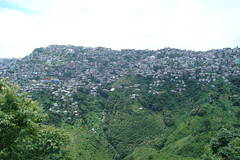 Image by bbcworldservice via Flickr
Image by bbcworldservice via Flickr
Aizawl: In contrast to the hot and humid climate of the Indian plains, Mizoram is a beautiful hilly region, a terrain so characteristically steep and green that one cannot help but admire.
But, for a person with disabilities, particularly wheelchair-bound persons, inconvenience outweighs the admiration.
"The challenges of making Mizoram a barrier free environment are paramount and manifold due to the topography of the region," said Liansangzuala, a young Mizoram Judicial Service officer who himself is a physically-challenged person.
He was one of the resource persons at a colloquium on ‘Making Mizoram a barrier free state for persons with disabilities’ organised by New Delhi-based Mission Maveen in association with the state social welfare department here on Tuesday.
In addition to the topographical difficulty, there is complete absence of disabled-friendly environment as "not even one per cent of the government offices, schools, colleges, churches and community halls in Mizoram are barrier-free for wheelchair-bound people," according to Liansangzuala.
Despite that the state government adopted the ‘Person with Disabilities (Equal Opportunities, Protection of Rights and Full Participation) Rules in 1999, little has been done to make the state a barrier free environment for people confined to the wheelchairs.
As on October, 2007, the state public works department has constructed entrance ramps and a few handicap toilets at eight government buildings mostly hospitals.
The Sarva Shiksha Abhiyan has also constructed 850 ramps and 1127 barrier-free toilets in schools, official reports said on Tuesday.
However, even in the national capital Delhi, a total barrier-free environment for the disabled persons is still a far cry, lamented Liansangzuala.
"Even the country’s capital is not equipped to provide a better life for the disabled," he said, adding, "lack of political will is the prime reason why the Indian government has failed to created a disabled-friendly environment."
Significantly, the Aizawl Development Authority Building Regulations 2008 makes it mandatory to make provision for a barrier free environment in public buildings.
Even if all the public buildings are made accessible with wheelchairs, the question is ‘How does a disabled person make it to the buildings?’
"There is topographical difficulty to overcome first, the fact that our state capital is not an architecturally planned city makes matter worse. Only a few houses in Aizawl are accessible with vehicles. But with an architectural planning, more than half of the problems could be solved," observed senior architecture George Lalzuia. (UNI)
But, for a person with disabilities, particularly wheelchair-bound persons, inconvenience outweighs the admiration.
"The challenges of making Mizoram a barrier free environment are paramount and manifold due to the topography of the region," said Liansangzuala, a young Mizoram Judicial Service officer who himself is a physically-challenged person.
He was one of the resource persons at a colloquium on ‘Making Mizoram a barrier free state for persons with disabilities’ organised by New Delhi-based Mission Maveen in association with the state social welfare department here on Tuesday.
In addition to the topographical difficulty, there is complete absence of disabled-friendly environment as "not even one per cent of the government offices, schools, colleges, churches and community halls in Mizoram are barrier-free for wheelchair-bound people," according to Liansangzuala.
Despite that the state government adopted the ‘Person with Disabilities (Equal Opportunities, Protection of Rights and Full Participation) Rules in 1999, little has been done to make the state a barrier free environment for people confined to the wheelchairs.
As on October, 2007, the state public works department has constructed entrance ramps and a few handicap toilets at eight government buildings mostly hospitals.
The Sarva Shiksha Abhiyan has also constructed 850 ramps and 1127 barrier-free toilets in schools, official reports said on Tuesday.
However, even in the national capital Delhi, a total barrier-free environment for the disabled persons is still a far cry, lamented Liansangzuala.
"Even the country’s capital is not equipped to provide a better life for the disabled," he said, adding, "lack of political will is the prime reason why the Indian government has failed to created a disabled-friendly environment."
Significantly, the Aizawl Development Authority Building Regulations 2008 makes it mandatory to make provision for a barrier free environment in public buildings.
Even if all the public buildings are made accessible with wheelchairs, the question is ‘How does a disabled person make it to the buildings?’
"There is topographical difficulty to overcome first, the fact that our state capital is not an architecturally planned city makes matter worse. Only a few houses in Aizawl are accessible with vehicles. But with an architectural planning, more than half of the problems could be solved," observed senior architecture George Lalzuia. (UNI)

![Reblog this post [with Zemanta]](http://img.zemanta.com/reblog_e.png?x-id=1bee75b5-9bee-4d19-8422-ac6e785c296b)
No comments:
Post a Comment